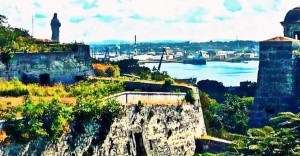A statue of Jesus overlooks Havana Bay in Cuba. It has a fascinating history.
In 1956, Marta Fernandez, the devout Catholic wife of Cuban dictator Fulgencio Batista, formed a committee to choose a sculptor to design and build a statue of Christ, which would overlook the city of Havana. Inspired, no doubt, by the statue of Christ the Redeemer, which overlooks Rio de Janeiro from Corcovado Mountain, she conducted a contest for the commission. Cuban sculptress, Jilma Madera, won.
The gifted female artist promised to build the monument using only the finest Carrara marble, quarried in Italy. It would stand sixty-six feet high and be mounted atop a marble platform ten feet tall. Its several sections, when assembled, would weigh 320 tons.
The committee selected a site on La Cabana Hill in the suburb of Casa Blanca. From a vantage point 260 feet above Havana Harbor, Christ Jesus would view the entire bay, the entrance to the harbor, and the city itself across the water.
The faithful of Havana could look across the bay toward the statue — blazing white under the Havana sun — and know in their hearts that Jesus loved them and watched over them.

It took nearly three years of hard work in both Italy and Cuba, but on Christmas day 1958 Marta dedicated the statue for the people of Cuba. From now on Jesus would defend them from every danger, including the danger posed by the brutal Communists against whom her husband’s army — with America’s help — battled valiantly on the eastern side of the island.
Marta didn’t know (how could she?) that six days after the dedication ceremony, she and her husband would find themselves scrambling into a convoy of planes to fly off the island with hundreds of their closest friends — fleeing for their lives — because guerilla soldiers had somehow overrun Santa Clara, her husband’s last line of defense.
The dirty unshaven mostly black soldiers, who belonged to the devil himself — Che Guevara — were poised to swarm into the city like the fire-ants every Christian knew they were.
Marta and her husband escaped the island after a New Years Eve party made famous in the 1974 classic movie, The Godfather Part Two, which featured Al Pacino. They took expensive art and the Cuban treasury with them, but left behind a 1.2 billion dollar debt as well as a history of annual deficits in the hundreds-of millions for the new government to repay.
In the meantime, while the Batista entourage continued to orchestrate its exile, during a freak storm, lightning struck Marta’s beloved statue of Jesus. Its head disintegrated some say and crashed to the ground.

It was just as well that Marta didn’t see it happen. She had worked so hard to bring this gift of God’s love to the citizens of Havana. The new government — it wouldn’t become a Communist government for a few more years — cleaned up the mess and rebuilt Jesus to his former glory.
As time went on, the powerful Batista family lived out its patriarch’s remaining years in various countries until Fulgencio died of a heart attack at age 72 in Marbella, Spain in 1973.
Marta moved to America where she lived quietly among the upscale and connected of Palm Springs, Florida. She continued giving to charity, the Church, and even hospitals until she too died, in 2006, from the complications of Alzheimer’s disease.
By all reports Marta was a beautiful Catholic, a Christian, a woman who loved Jesus. But she married a man who John Kennedy once said had run the most repressive and corrupt régime that South America had ever seen.
Havana, under Batista, became a modern-day Sodom and Gomorrah. Sicilian Americans in crime syndicates (years later people started calling these groups, the Mafia) operated profitable casinos, as well as gambling, pornography, and prostitution franchises.
In those days, despite American investment (Americans owned three-fourths of pretty much every category of the economy, including land) dissatisfaction ran deep. Universities became hotbeds of discontent, protests, and demonstrations. Trade unions, the press, teachers, agricultural workers, priests, doctors, and lawyers vented their collective outrage at “yanqui” unfairness and domination.
The entire country, 90% of it anyway, congealed in disgust for the goons who ran everything; who stole the island’s wealth in a seemingly endless orgy of greed. Disgust turned to fear when thugs began a regimen of assassination and torture to keep dissenters in check.

Eventually, Fidel Castro, a brilliant attorney and son of a prominent land owner, stepped up to coordinate the opposition, which had become so complex and unwieldy that it was almost impossible to track, let alone direct. He hired a savvy Argentine physician, Ernesto (Che) Guevara, to help him. As time went on they became close friends and made history together.
After the Batista family and their closest friends fled the island, Castro arrested the men who carried out the assassinations and torture of civilians. The new government executed several hundred for capital crimes. It sentenced hundreds more to long prison terms.
Fidel then broke up his own family’s estate by distributing its land to his family’s employees. This generous act set the tone and example for the program of island-wide agrarian reform which followed.

The elites in the United States were not impressed. They orchestrated a program of assassinations, sabotage, bombings, quarantine, and isolation against the island that included poisoning its agricultural exports and burning and sinking the ships of its trading partners.
The USA established an embargo so effective that some international companies lobbied Congress to make humanitarian changes, which they did.
The USA embargo continues to the present day despite resumption of full diplomatic relations between the two countries this year.

The decades-long barbarity of the war against Cuba by the United States shocked the modern world. Many observers (outside the United States) continue to wonder how well Cuba might have done had it not endured decades of ”dirty tricks” to undermine its vision.
Some of the methods used to destabilize the island have made it into the public domain where observers have labeled them ”diabolical.” The history of USA-Cuba relations continues to alarm people around the world. Folks wonder if the United States will ever change. They wonder if the empire to the north can change.
A few of the excesses of the fifty-five year war against Cuba are enumerated in my essay, Hey, Guevara.
But to conclude our story…
As for Marta’s statue of Jesus, it continues to guard Havana Bay to this very day. Despite fifty-five years of relentless attack from what is arguably the most militarized and corrupt nation ever, the island of Cuba and its statue of Jesus still stand.
Billy Lee


